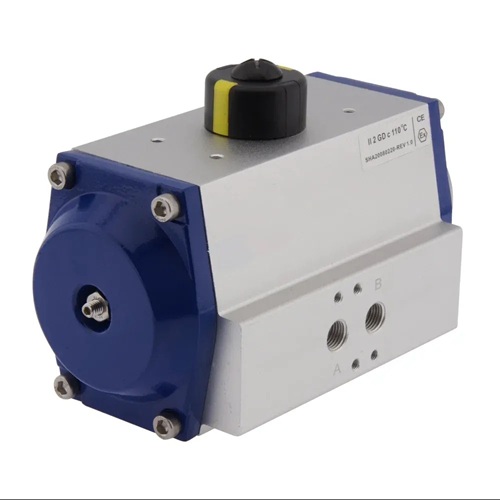


Pneumatic Quarter-Turn Actuators: Revolutionizing Valve Automation
We are a leading control valve manufacturer in China, providing high-quality valves and control actuators designed to meet a wide range of industrial requirements.
In industrial automation, achieving efficiency, reliability, and cost-effectiveness is crucial. Pneumatic quarter-turn actuators have emerged as a transformative solution for automating ball and butterfly valves, enabling remote operation through compressed air. These actuators enhance system automation, especially for larger valves, while maintaining relatively low investment costs. Their compatibility with ISO 5211 F07 valves and durable construction makes them a preferred choice for industries aiming to optimize operations.
This article explores the features, benefits, and key considerations of pneumatic quarter-turn actuators, providing a comprehensive understanding of their functionality, applications, and advantages. Whether you’re an engineer, plant manager, or automation specialist, gaining insights into these actuators can help you make informed decisions for your automation systems.
Pneumatic quarter-turn actuators are mechanical devices that convert compressed air into rotational motion, typically used to control quarter-turn valves such as ball or butterfly valves. Designed for precision and reliability, these actuators are ideal for applications requiring automation and remote operation.
They are compatible with valves featuring an ISO 5211 mounting flange, ensuring easy integration. With a 17 mm star connection for square drive shafts and available adapters for different shaft sizes, they offer exceptional flexibility for various valve configurations.
Double-acting actuators provide superior bidirectional control compared to single-acting models, ensuring precise valve operation.
These actuators seamlessly integrate with most quarter-turn valves featuring ISO 5211 F07 mounting flanges, making them highly versatile.
The direct mounting of a Namur solenoid valve eliminates additional fittings and tubing, streamlining installation and reducing potential leakage points.
Pneumatic actuators enable fast opening and closing speeds, significantly enhancing process efficiency.
A mechanical indicator on the actuator’s top offers a clear visual representation of valve position, aiding in monitoring and maintenance.
ATEX-certified actuators are safe for explosive environments, making them suitable for industries such as oil and gas, chemical processing, and mining.
Double-acting actuators consume more compressed air than single-acting models, leading to higher operational costs in air-intensive systems.
Since these actuators require a compressed air supply and solenoid valve, they may not be suitable for facilities without existing pneumatic infrastructure.
Pneumatic actuators generally have higher energy consumption than electric alternatives, which can impact overall efficiency.
Used in pipelines, refineries, and offshore platforms, these actuators provide reliable valve control in hazardous environments.
Constructed with durable, corrosion-resistant materials, they are ideal for handling aggressive chemicals and high-temperature processes.
Essential for automating valves in water treatment plants, ensuring efficient flow control and system reliability.
Widely used for hygienic applications such as filling, mixing, and packaging automation.
Preferred for their precise control and clean operation in pharmaceutical production processes.
Before installation, verify that the actuator matches the valve’s flange dimensions and shaft size based on the datasheet specifications.
Installing throttle valves on the actuator’s outlet ports (after the solenoid valve) allows better control over rotation speed.
Periodically check for signs of wear, leaks, or damage, and replace components as needed to maintain performance.
Proper lubrication of moving parts reduces friction and extends actuator service life.
Maintain a clean and consistent air supply to prevent contamination and ensure reliable operation.
Pneumatic quarter-turn actuators offer a powerful solution for enhancing automation and control in industrial systems. Their robust design, compatibility with ISO 5211 F07 valves, and ATEX certification make them a dependable choice across various industries. While they have some limitations, such as increased air consumption, their advantages typically outweigh these considerations.
By understanding the capabilities and applications of these actuators, you can make informed decisions to optimize your systems and improve efficiency. Whether operating in oil and gas, chemical processing, or water treatment, pneumatic quarter-turn actuators provide a cost-effective and reliable automation solution.
As industries continue to embrace automation, these actuators will remain integral to driving innovation and efficiency, ensuring their continued importance in modern industrial automation.
